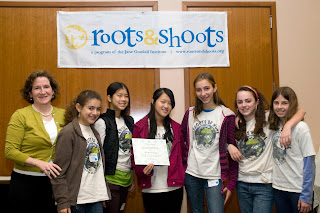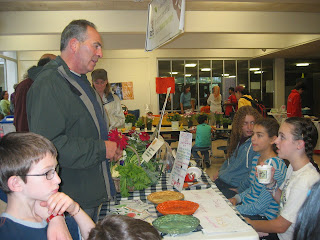By Eve

On Saturday, November 14 the Sprouts of Hope went to the annual Roots & Shoots Youth Summit in Boston. At the start, Sally Sharp Lehman, who directs the New England chapter of Roots & Shoots, talked about the Jane Goodall Institute, specifically its Africa program and how it is working and planning to take care of more and more orphaned chimpanzees.

On Saturday, November 14 the Sprouts of Hope went to the annual Roots & Shoots Youth Summit in Boston. At the start, Sally Sharp Lehman, who directs the New England chapter of Roots & Shoots, talked about the Jane Goodall Institute, specifically its Africa program and how it is working and planning to take care of more and more orphaned chimpanzees.
Awards were also presented to regional Roots & Shoots groups as a way of showing appreciation for the efforts they made during the year. For the second year in a row the Sprouts of Hope were recognized as the “outstanding group” in the New
 England region, and this year our adult leader, Melissa, was named the region’s “Outstanding Group Leader.”
England region, and this year our adult leader, Melissa, was named the region’s “Outstanding Group Leader.”Throughout the rest of the day, we went to our various workshops. And during the lunch break, John Taguiri, a photographer and artist who has partnered a lot with us on projects, took photos of all of the kids who came to the Youth Summit.

John set it up a mini-photo studio at the summit so the people would be shown kicking away plastic water bottles while holding a reusable water bottle. And they would be standing on top of the world. It looked really cool. You can see what it looked like when Lilly posed for the picture.
Lilly, Eliza, Risa, and I went to a workshop called “Drop of Hope - Bottled Water and Our Public Water System.” This workshop inspired me to not drink bottled water. We learned that all bottled water is really just tap water that is purified. Then, it is sold for around $1.75 a bottle, when you could be getting almost the same water for a few cents at home. But when you are drinking water at home, you aren't putting plastic into the landfills, or the ocean.
There is a giant island of trash in the Pacific Ocean called the Great Pacific Garbage Patch. It is an island of floating plastic and debris that is two times the size of Texas. It is in the middle of the Pacific Ocean right now, but it's heading toward Hawaii. Since it is in the middle of the ocean, it's nobody’s property, so it's nobody's responsibility to clean it up. About 86% of plastic bottles go into the landfills or the ocean. Only 14% are recycled. Here’s a link to a slideshow about this enormous Great Pacific Garbage Patch:
http://www.nytimes.com/slideshow/2009/11/09/science/11102009_Garbage_index.html
There is a giant island of trash in the Pacific Ocean called the Great Pacific Garbage Patch. It is an island of floating plastic and debris that is two times the size of Texas. It is in the middle of the Pacific Ocean right now, but it's heading toward Hawaii. Since it is in the middle of the ocean, it's nobody’s property, so it's nobody's responsibility to clean it up. About 86% of plastic bottles go into the landfills or the ocean. Only 14% are recycled. Here’s a link to a slideshow about this enormous Great Pacific Garbage Patch:
http://www.nytimes.com/slideshow/2009/11/09/science/11102009_Garbage_index.html
And there is a Web site, http://www.greatgarbagepatch.org/ where you can learn more this ocean garbage patch and also about ways to make people aware of how to stop producing so much garbage by throwing away so many plastic bottles.
We also learned about the water that gets sold in plastic bottles and how companies get it. Usually companies go into small towns that can’t afford to or aren’t strong enough to push them out. Sometimes there will be many days when the water supply for the citizens runs out, while the water factories are still pumping water out of the ground. Then, they bottle it up, which takes a lot of energy, and ship it to stores, which also requires energy, and then they sell it.
The main problem of bottled water, though, is the water itself. The people who spoke to us said that the bottles send chemicals into the water when you leave water in the bottle too long or when you reuse the bottles. Also, we were told that only one person checks the clean-ness of these companies’ water; she has other jobs, too, which means that her mind isn’t even fully into the job. As for tap water from your homes, the Environmental Protection Agency (EPA) – along with local water departments, like ours in Cambridge, MA – oversees keeping the public water supply healthy. If the Food and Drug Administration – the government agency that checks bottled water – finds anything in this water, the company of the dirty water just has to slip it off the shelf. They don't have to tell anyone. Also, any plastic that goes into the ocean can be eaten by fish, then we catch the fish, and we eat the fish along with any plastic that is in the fish.
Of course, I am just reporting what we were told in this workshop. We should do our own research and see what we find out about the business of putting water into plastic bottles. To learn more about the bottled water, you can go to www.empowerbrown.org/blog/ to find out what students at Brown University are doing to try to help the environment on their campus by trying to get students there to stop drinking water out of plastic bottles. Or you can go to dropofhopenews.blogspot.com for information and news about water, especially bottled water.
Even if you don't have time to do any research, you can at least go out and buy a reusable water bottle. They might be expensive to buy, but in the long run using one will save you money and your health.
your health.
Toward the end of the day the Sprouts (except for Maya, who went to a workshop about the treatment of greyhounds) went to a panel where Lilly and Kaya talked about things we are doing to try to help people save energy and help the earth. And we learned from others who talked about projects like working to make the roof of their school building green and going to the statehouse to meet with legislators about global warming.
Watch and listen on YouTube to Lilly and Kaya talk about some of the Sprouts’ energy-saving projects.
We also learned about the water that gets sold in plastic bottles and how companies get it. Usually companies go into small towns that can’t afford to or aren’t strong enough to push them out. Sometimes there will be many days when the water supply for the citizens runs out, while the water factories are still pumping water out of the ground. Then, they bottle it up, which takes a lot of energy, and ship it to stores, which also requires energy, and then they sell it.
The main problem of bottled water, though, is the water itself. The people who spoke to us said that the bottles send chemicals into the water when you leave water in the bottle too long or when you reuse the bottles. Also, we were told that only one person checks the clean-ness of these companies’ water; she has other jobs, too, which means that her mind isn’t even fully into the job. As for tap water from your homes, the Environmental Protection Agency (EPA) – along with local water departments, like ours in Cambridge, MA – oversees keeping the public water supply healthy. If the Food and Drug Administration – the government agency that checks bottled water – finds anything in this water, the company of the dirty water just has to slip it off the shelf. They don't have to tell anyone. Also, any plastic that goes into the ocean can be eaten by fish, then we catch the fish, and we eat the fish along with any plastic that is in the fish.
Of course, I am just reporting what we were told in this workshop. We should do our own research and see what we find out about the business of putting water into plastic bottles. To learn more about the bottled water, you can go to www.empowerbrown.org/blog/ to find out what students at Brown University are doing to try to help the environment on their campus by trying to get students there to stop drinking water out of plastic bottles. Or you can go to dropofhopenews.blogspot.com for information and news about water, especially bottled water.
Even if you don't have time to do any research, you can at least go out and buy a reusable water bottle. They might be expensive to buy, but in the long run using one will save you money and
 your health.
your health.Toward the end of the day the Sprouts (except for Maya, who went to a workshop about the treatment of greyhounds) went to a panel where Lilly and Kaya talked about things we are doing to try to help people save energy and help the earth. And we learned from others who talked about projects like working to make the roof of their school building green and going to the statehouse to meet with legislators about global warming.
Watch and listen on YouTube to Lilly and Kaya talk about some of the Sprouts’ energy-saving projects.
http://www.youtube.com/user/sproutsoh7#p/a/u/0/Jujz2WFELnQ
It was a very inspiring day for all of us who were at the Youth Summit.

























 On the matching felt patch, we wrote: Geothermal heat pumps use the temperature underground as a source of energy. They use 25 to 50 percent less electricity than conventional heating.
On the matching felt patch, we wrote: Geothermal heat pumps use the temperature underground as a source of energy. They use 25 to 50 percent less electricity than conventional heating.




















 The younger kids got to see a slide show that the Sprouts of Hope had made of students at King Open bringing eco-friendly containers and recycling their polystyrene trays during Waste Free Lunch days on days when we tried doing them at our school.
The younger kids got to see a slide show that the Sprouts of Hope had made of students at King Open bringing eco-friendly containers and recycling their polystyrene trays during Waste Free Lunch days on days when we tried doing them at our school.



